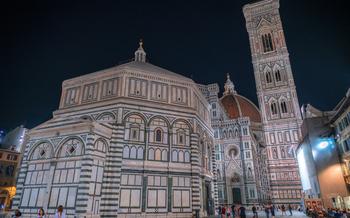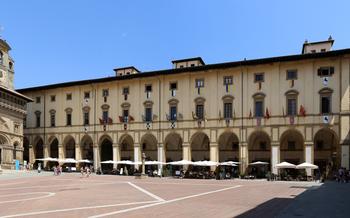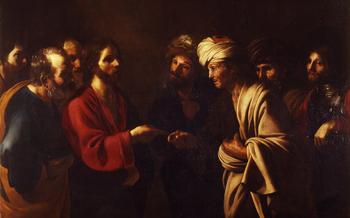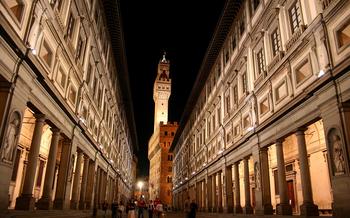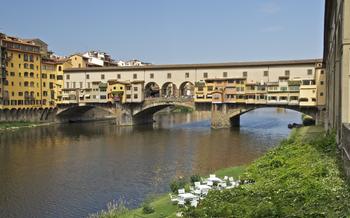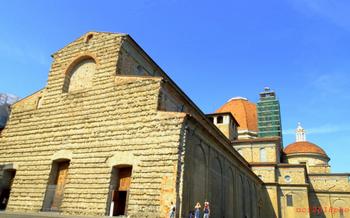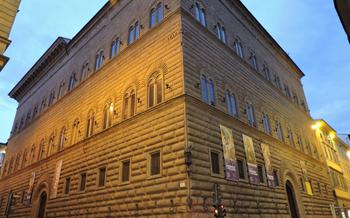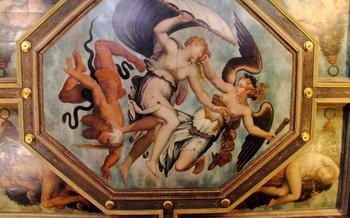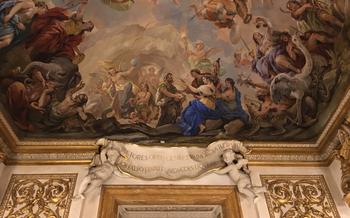
Palazzo Vecchio
- Introduction
- Exploring the Palazzo Vecchio
- Hidden Gems of Palazzo Vecchio
- The Vasari Corridor
- Tickets and Guided Tours
- Hours of Operation
- Getting There
- Places to Eat Nearby
- Things to Do Nearby
- Photography and Videography
- Accessibility for Visitors with Disabilities
- Visiting with Children
- Dress Code
- Events and Exhibitions
- Insider Tip
- Insider Tip: Unveil the Hidden Terrace
Introduction
In the heart of Florence, Italy, stands Palazzo Vecchio, a majestic testament to the city's rich history and architectural prowess. Once the seat of the Florentine Republic and later the residence of the Medici family, this 14th-century palace is a treasure trove of art, history, and intrigue. Its imposing facade, adorned with intricate carvings and a distinctive crenellated tower, reflects the grandeur and power of the city-state it represents. Palazzo Vecchio's unique blend of Gothic and Renaissance architectural styles makes it an iconic landmark and a must-see for any visitor to Florence.
Exploring the Palazzo Vecchio
As you step inside the Palazzo Vecchio, you'll be greeted by the vast and impressive courtyard, adorned with intricate carvings, sculptures, and a central fountain. Take a moment to admire the architectural details of the courtyard, including the elegant arches, columns, and the distinctive clock tower that rises above.
Climb the Torre di Arnolfo, the iconic tower of the Palazzo Vecchio, for breathtaking panoramic views of Florence. Enjoy the bird's-eye perspective of the city's terracotta rooftops, the Duomo's majestic dome, and the winding Arno River. The tower not only offers stunning vistas but also holds historical significance, having served as a watchtower and a symbol of the city's independence.
The Palazzo Vecchio is home to several grand halls, each with its unique character and historical significance. The Hall of the Five Hundred, the largest room in the palace, is a testament to the grandeur of the Florentine Republic. With its soaring ceiling, ornate frescoes, and monumental sculptures, it served as the meeting place for the city's ruling council.
Discover the Hall of Geographical Maps, where 53 frescoed maps depict the world as it was known in the 16th century. These maps offer a glimpse into the geographical knowledge of the time and showcase the artistic skills of the Renaissance cartographers. Adjoining this hall is the Hall of the Elements, adorned with frescoes representing the four elements: fire, water, earth, and air.
Hidden Gems of Palazzo Vecchio
Beyond the grand halls and public spaces of Palazzo Vecchio, there lie hidden treasures known only to a select few. One of these is the intricate network of secret passages and staircases used by the Medici family to move undetected throughout the palace. These secret routes allowed the Medici to escape danger, conduct private meetings, and keep a watchful eye on their subjects.
Another hidden gem is the Studiolo of Francesco I, a private study adorned with exquisite artwork and craftsmanship. This room was a sanctuary for the Grand Duke Francesco I de' Medici, where he could indulge in his passion for the arts, sciences, and alchemy. The walls of the studiolo are covered in intricately carved wooden panels, each depicting a different aspect of the natural world. The ceiling is adorned with a stunning fresco depicting the heavens, complete with constellations and celestial bodies.
The Vasari Corridor
The Vasari Corridor is an enclosed elevated passageway that connects the Palazzo Vecchio to the Uffizi Gallery, spanning the Arno River and passing through the Uffizi courtyard. Commissioned by Cosimo I de' Medici in 1565, it was designed by Giorgio Vasari to provide the Medici family with a safe and private passageway between their residence and the government offices.
This secret passageway, measuring about 1 km in length, is adorned with over 1,000 paintings, mostly portraits of famous people from history, mythology, and the Medici family itself. The corridor also offers stunning views of the city, including the Arno River and the Ponte Vecchio.
Among the notable artworks displayed along the corridor are self-portraits by Giorgio Vasari and Rembrandt, as well as works by Pontormo, Bronzino, and Federico Barocci. Visitors can access the Vasari Corridor through the Uffizi Gallery or by booking a guided tour specifically for the corridor.
Tickets and Guided Tours
Admission to the Palazzo Vecchio requires a ticket, which can be purchased on-site or booked in advance online. Standard ticket prices vary depending on the time of year and any special exhibitions or events. Reduced rates are available for students, seniors, and holders of certain cultural cards.
Guided tours of the Palazzo Vecchio are highly recommended, as they provide in-depth insights into the history, architecture, and artwork of this magnificent building. Tours are available in various languages and typically last around an hour. Visitors can choose from general tours that cover the main highlights to more specialized tours focusing on specific aspects of the Palazzo Vecchio, such as its secret passages or the Medici family's role in its history.
Booking tickets in advance, especially during peak tourist season, is advisable to avoid long lines and ensure a spot on the desired tour. Online booking platforms often offer the convenience of selecting a specific time slot and language preference. Group discounts and special offers may be available for larger groups or educational institutions.
Hours of Operation
The Palazzo Vecchio adheres to specific opening hours, allowing visitors to plan their visit accordingly. During regular weekdays, its doors are open from 9:00 AM to 7:00 PM, providing ample time to explore its grandeur. However, it's worth noting that the Palazzo Vecchio observes special openings or extended hours during certain periods of the year, such as during major holidays or events. To ensure your visit aligns with the Palazzo's operating schedule, it's advisable to check their official website or contact the information desk for up-to-date information. Additionally, please be aware that the Palazzo Vecchio is closed to the public on the first and third Monday of each month. Plan your visit accordingly to avoid any inconvenience and make the most of your time in this magnificent palace.
Getting There
-
Location: Piazza della Signoria, 50122 Florence, Italy. The Palazzo Vecchio is situated in the heart of Florence, overlooking the Piazza della Signoria and the Uffizi Gallery.
-
Public Transportation: The city's extensive public transportation network makes it easy to reach the Palazzo Vecchio. Take bus lines C1, C2, C3, or 11 to the "Uffizi" stop, which is right in front of the Palazzo. Alternatively, tram line 1 stops at the "Santa Maria Novella" stop, a short walk from the Palazzo.
-
Parking: Limited street parking is available in the surrounding area. For more convenient options, consider parking in one of the nearby garages or parking lots, such as the Garage La Monnalisa or the Parcheggio Sant'Ambrogio.
Places to Eat Nearby
After exploring the magnificent Palazzo Vecchio, you'll likely crave some nourishment to replenish your energy. Luckily, the surrounding area offers a plethora of culinary delights to satisfy every palate.
For a taste of traditional Florentine cuisine, venture to Trattoria Mario, a beloved local gem just a stone's throw away. Their mouthwatering pasta dishes, prepared with fresh, seasonal ingredients, are a must-try.
If you're in the mood for a quick bite or a caffeine fix, head to Caffè degli Artisti, a charming café frequented by locals and tourists alike. Their delectable pastries and aromatic coffee will surely hit the spot.
Indulge your sweet tooth at Gelateria La Carraia, renowned for its creamy gelato made with local, artisanal ingredients. Their inventive flavors, like lavender and honey or pistachio and saffron, are a feast for the senses.
Things to Do Nearby
Oltre al vasto patrimonio artistico e storico contenuto al suo interno, il Palazzo Vecchio gode anche di una posizione privilegiata nel cuore di Firenze, a pochi minuti a piedi da alcune delle attrazioni più famose della città.
A pochi passi dal Palazzo Vecchio si trova la Galleria degli Uffizi, una delle gallerie d'arte più famose al mondo, che ospita capolavori del Rinascimento italiano come la Nascita di Venere di Botticelli e la Primavera di Sandro Botticelli. La Galleria degli Uffizi è un must per gli amanti dell'arte e dovrebbe essere in cima alla lista di cose da vedere a Firenze.
Vicino al Palazzo Vecchio si trova anche l'iconico Ponte Vecchio, l'unico ponte a Firenze che fu risparmiato dalla distruzione durante la Seconda Guerra Mondiale. Il Ponte Vecchio è famoso per le sue botteghe di gioielleria e orologi, che si trovano lungo il ponte e offrono una vasta gamma di gioielli e orologi di alta qualità.
A pochi passi dal Palazzo Vecchio si trova anche Piazza della Signoria, una delle piazze più belle e importanti di Firenze. La piazza è dominata dal Palazzo Vecchio e dalla Loggia dei Lanzi, che ospita copie di famose sculture come il David di Michelangelo e il Perseo di Benvenuto Cellini.
In Piazza della Signoria si trova anche la Fontana del Nettuno, una delle fontane più famose di Firenze. La fontana fu costruita nel XVI secolo da Bartolomeo Ammannati e raffigura il dio del mare Nettuno circondato da quattro cavalli marini.
Photography and Videography
Capturing the beauty of the Palazzo Vecchio through photography or videography is a fantastic way to preserve your memories. However, it's important to be aware of the photography rules and restrictions in place to ensure you have a respectful and enjoyable experience.
-
Photography Allowed: Photography is generally allowed inside the Palazzo Vecchio, but there are certain areas where photography may be restricted, such as the Hall of the Five Hundred during official events.
-
Tripods and Selfie Sticks: The use of tripods and selfie sticks is not permitted inside the Palazzo Vecchio to prevent damage to the historic interiors and ensure the safety of visitors.
-
Flash Photography: The use of flash photography is prohibited inside the Palazzo Vecchio to protect the delicate artworks and frescoes from damage caused by intense light.
By following these guidelines, you can respectfully capture your visit to the Palazzo Vecchio while ensuring the preservation of this historic landmark for future generations.
Accessibility for Visitors with Disabilities
The Palazzo Vecchio recognizes the importance of accessibility for visitors with disabilities. The historic building features wheelchair ramps and elevators, ensuring that all levels are accessible to those with limited mobility. Visitors can request assistance from the staff upon arrival, who are happy to provide guidance and support throughout their visit. Detailed maps and guides with accessible routes are available at the information desk to enhance the experience for visitors with disabilities. The Palazzo Vecchio continuously strives to create an inclusive environment, allowing everyone to explore and appreciate its architectural and historical wonders.
Visiting with Children
When exploring the Palazzo Vecchio with young ones, make sure to engage them with interactive and educational activities. The museum offers a range of family-friendly exhibits and experiences that bring history to life for kids. Look for hands-on displays, multimedia presentations, and interactive touchscreens that allow children to learn about the palace's rich past in a fun and engaging way.
Audio guides designed specifically for children are available, providing engaging narratives and interesting facts about the various rooms and exhibits. These guides help capture kids' attention and make the visit more enjoyable and educational.
Guided tours tailored for families are also available, offering a kid-friendly approach to exploring the Palazzo Vecchio. These tours often include interactive activities, storytelling, and games that keep children entertained while learning about the palace's history and significance.
Dress Code
When visiting the Palazzo Vecchio, it is essential to dress appropriately, showing respect for the historical and institutional significance of the building. Avoid wearing overly casual or revealing clothing, such as shorts, tank tops, or flip-flops. Instead, opt for smart casual attire that is both comfortable and respectful. For men, a pair of chinos or dress pants with a button-down shirt or polo shirt is suitable. Women can choose a dress, skirt, or pantsuit with a blouse or sweater. Remember that the Palazzo Vecchio is a government building and a symbol of Florentine history, so dressing appropriately demonstrates respect and consideration for the institution.
Events and Exhibitions
The Palazzo Vecchio is not just a historical landmark but also a vibrant cultural center that hosts a variety of temporary exhibitions and events throughout the year. These exhibitions showcase a diverse range of art, history, and culture, providing visitors with a unique opportunity to delve deeper into the rich heritage of Florence.
Insider Tip
The Palazzo Vecchio's secret terrace offers breathtaking panoramic views of the city. This hidden gem is typically accessible only through guided tours, so be sure to inquire about availability and book your spot in advance to avoid disappointment.
Insider Tip: Unveil the Hidden Terrace
Unveiling a hidden gem within the Palazzo Vecchio, discover the Secret Terrace, an exclusive vantage point accessible through guided tours. Ascend to the rooftop of this historic building and be rewarded with breathtaking panoramic vistas of Florence. From this elevated perch, soak in the beauty of the city's terracotta rooftops, the majestic Duomo, and the winding Arno River. Capture unforgettable moments as you witness the sun casting a golden glow over the cityscape, creating a magical ambiance. Embrace the opportunity to delve into the secrets of the Palazzo Vecchio and to experience Florence from a unique and privileged perspective.
